Among the most famous pilgrim towns for followers of Vaishnavism in India, Vrindavan was the playground of blue god Krishna and his spiritual consort Radha

A 365-day destination, Vrindavan is where everyone comes in search of the love that Krishna and Radha stand for—a divine spiritual bond that surpasses cast, creed, age and norms. My visit to Vrindavan wasn’t the first one. I had visited the city with my astrological guru, KN Rao, way back in 2000. An ardent Krishna devotee, he taught me how to recite strotras, instilling discipline in various ways; to give examples, listening to a speaker with attention during a conference, not talking when a prayer is in progress, focusing on your goal, fulfilling your karma because there’s no escaping it.
But this time, it was a trip to experience the city on invitation by Nidhivan Sarovar Portico. Just a two-hour journey from my home, I reached close to lunch. And then gorged on a traditional Braj lunch thali—some veggies, roti, rice and sweets. This region around both the shores of the Yamuna is known as Braj or Brijbhoomi. Derived from the Sanskrit word vraja, it means a pasture, shelter or resort for cattle. The word is mentioned in the Rigveda, oldest Sanskrittextdated to 1500–1000 BCE. Well, you do see the cattle, albeit abandoned, but the pastures have been lost to urbanization.

The area around Vrindavan, comprising Barsana, Nandgaon, Mathura, Gokul, Govardhan and Bhandivan, is replete with temples and tales of Krishna’s childhood. You will constantly hear the words Radhey Radhey and it is a call to give them way and people also meet and greet with this call, hands folded in a namaskar and head bowing.
Vrindavan derives its name from vrinda, that is the holy basil, and van means grove. Of course, the groves are long gone, though some smattering of the holy basil can be seen in temples. Vrindavan has been mentioned in Mahabharata, written in 3rd century BC. The city did get lost in time, but it was in the 16th century that Chaitanya Mahaprabhu visited Vrindavan to locate the holy places associated with Krishna. This saint founded the Gaudiya Vaishnavism Achintya Bheda Abheda, expounded bhakti yoga and popularized the Hare Krishna mantra.
Even though I was quite aware of the crowd in the city, it does get uneasy. Thronged with beggars and widows, it can become quite a depressing experience. In fact, the city has the most number of widows, close to 20,000. Coming from as far as West Bengal, Assam and Odisha, they live on the roads, clad in their white saris, singing bhajans. Lately, the government and NGOs took notice of their plight and now most get a place to stay with food. Also, I am not friends with religion and its rigorous keepers, but I simply love the healing power of prayers.
So, when the hotel provided a guide, it was helpful for he knew the ins and outs, as most locals do. Ashu Sharma, belonged to a family of traditional priests and now along with friends had started the website, vrindavanguide.com. He introduced me to some sights that I had not seen on my previous trips.
1. Evening Arati at Kesi Ghat, Yamuna
As a newbie photographer, Kesi Ghat with its evening aarti was just the right place to hone my skills. This is the place where Krishna killed the demonic horse Kesi who had been sent by his uncle Kansa to kill him. Krishna had broken open his head and then bathed in the Yamuna to wash the blood off. It’s here that people come to wash away their sins but now the black river needs cleansing. The dilapidated surroundings could do with a facelift. However, the desire to be free of suffering keeps surfacing and people keep trying to find their beloved god here.
Faith has many faces and water bodies have been worshipped since eternity, being the nourishers of life. Man and the elements have had an eternal relationship; prayer to the river is the one way to observe how water, air, ether, fire and earth connect. Invoking the river goddess, the devotees offered flowers, milk, floated diyas, as the priests blew the conch and chanted mantras. In another corner, a religious head and his disciples created a circle of boats, holding a circle of saris tied together. The goddess was being clothed even as the sun was setting. As the sound of mantras and drums stopped, the fervent devotees put out their hands for the sweet prasad.
Nevertheless, faith has many faces. Man and the elements have had an eternal relationship; prayer to the river is the one way to observe how water, air, ether, fire and earth connect. Invoking the goddess, the devotees offered flowers, milk, floated diyas, as the priests blew the conch and chanted mantras. In another corner, a religious head and his disciples created a circle of boats, holding a circle of saris tied together. The goddess was being clothed even as the sun was setting.
2. Musical Fountains, Prem Mandir

The fountains have been installed by a Melbourne-based company and the changing colours added some glitz to the darkness. This temple is located on the outskirts of the city on a 54-acre site. Built by spiritual guru Kripalu Maharaj, this marble temple has scenes from Krishna’s life in the gardens.
3. Radha Raman Temple
The fragrant smoke of incense from every corner cannot hide the strong smell of an unclean city. Jostling crowd and beseeching eyes, we continued our way to another temple–Radha Raman temple, located in the smaller bylanes.

The exquisitely carved walls are inviting. The temple was built by Gopala Bhatta Goswami around 1542 AD. It’s very famous among the Gaudiya Vaishnavism followers and houses an original shaligram and Radha. A shaligram is a particular stone collected from riverbed of Kali Gandaki, a tributary of the Gandaki River in Nepal, considered holy because it bears natural symbols associated with Vishnu.
Bhajans were in full swing as the sanctum doors were closed. They would open for the last prayer when the preparation for the god’s bedtime finished. I listened for a while but when holy lyrics mingled with Bollywood tunes, I called it a night.
4. Radha Temple at Barsana

The sunrise at Barsana is a splendour that you can’t miss when in Vrindavan. The region is the birthplace of Radha and among the most revered spots in Braj. Despite the monkeys, I love being atop the hill from where you can see the entire town. It was a glorious day, just enough chill to make you want to fly. As the temple doors were closed, devotees were busy with bhajans on the terrace.
Barsana is also famous for latha maar holi, where the women actually beat up the men with bamboo sticks and prevent them from coming closer. On how this originated, legend goes that Krishna made fun of Radha’s friends. In turn, they beat him and his friends with bamboo sticks when he came to play holi with Radha.
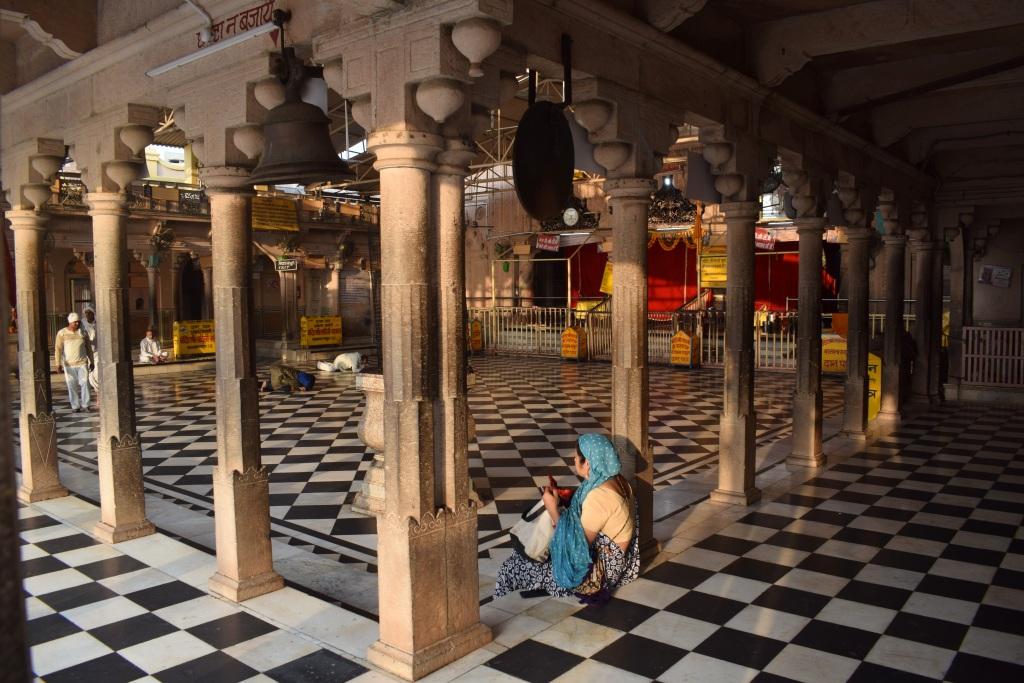
With each ray, colour seeped into the quiet hill. The rays danced into the temple. The crowd collected closer to the sanctum. Finally, the curtains lifted. But I couldn’t push through the crowd and my guide got me a handful of prasad.
5. Embroidering Clothes for the Gods
Evading the monkeys, we zoomed through the streets to the home of Brij Mohan Sharma. He runs an embroidery unit, making beautiful clothes for the idols in ISKCON temple. Some are made on silk, some on cotton, depending on the need and the designs given by the head of the division at the temple. The clothes even go to the temple in Hungary and he was invited to the country which awarded him for his efforts. While his son isn’t too keen on joining the unit, Sharma is content with his work. “I started my career as a worker, embroidering in a unit, and now with Krishna’s blessings I have this unit. This is the only service I do for god.”
6. The Banyan Tree at Vansivat
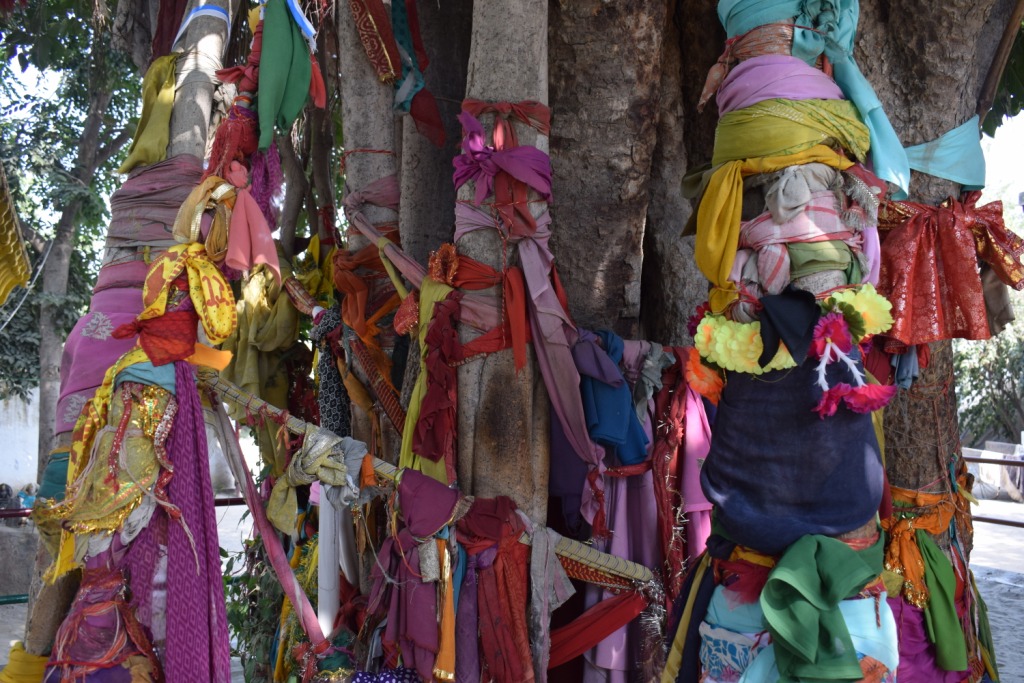
The afternoon had not ended as we drove to Vansivat—the ages old banyan tree under which Krishna used to play the flute. Vansi or bansi is flute and vat is banyan tree. Peacocks danced here then. Now, people tie dupattas, hanging their wishes on the branches for Krishna to fulfil them.
I ended my day at the spa in the hotel with a fabulous massage and a facial before heading home. But Vrindavan doesn’t tire and continues to draw seekers.
More Popular Attractions
- Banke Bihari temple in the heart of the city is the most visited temple. This is also the area to try some local delicacies such as kachoris, poori bhajis, pedas, lassis. Pedas are a must eat there.
- More temples include ISKCON, Nidhivan, Krishna Janam Bhoomi, Madan Mohan.
- For the ardent devotee, the long parikramas around Govardhan and Vrindavan are a good way to walk off your karma. Parikrama/Paridakshina or spiritual walk, is circumambulation of a sacred entity, that is done in contemplation of the divine, fulfilling the circle of life.
Things to keep in mind
- Please keep yourself covered, keeping the sanctity of the spiritual place.
- Vrindavan is home to monkeys, and they run away with your sunshades and other articles. Please keep your bag and belongings zipped.
- The city is full of beggars, but many ashrams and people feed them regularly.
- It is better to have some change, should you like to go temple hopping and donate.
- Cash and Paytm are better ways to pay if you buy anything.
Where to stay: You can also stay in ashrams and ISCKON has a place too.But it’s best to book your stay in advance.
How to reach: It takes two hours by road from Delhi via Yamuna Expressway. Or you could go in the train as well.

This blog post is part of #BlogchatterA2Z 2023 challenge.
Read previous posts A, B, C, D, E, F, G, H, I. J, K, L, M, N, O, P, Q, R, S, T, U


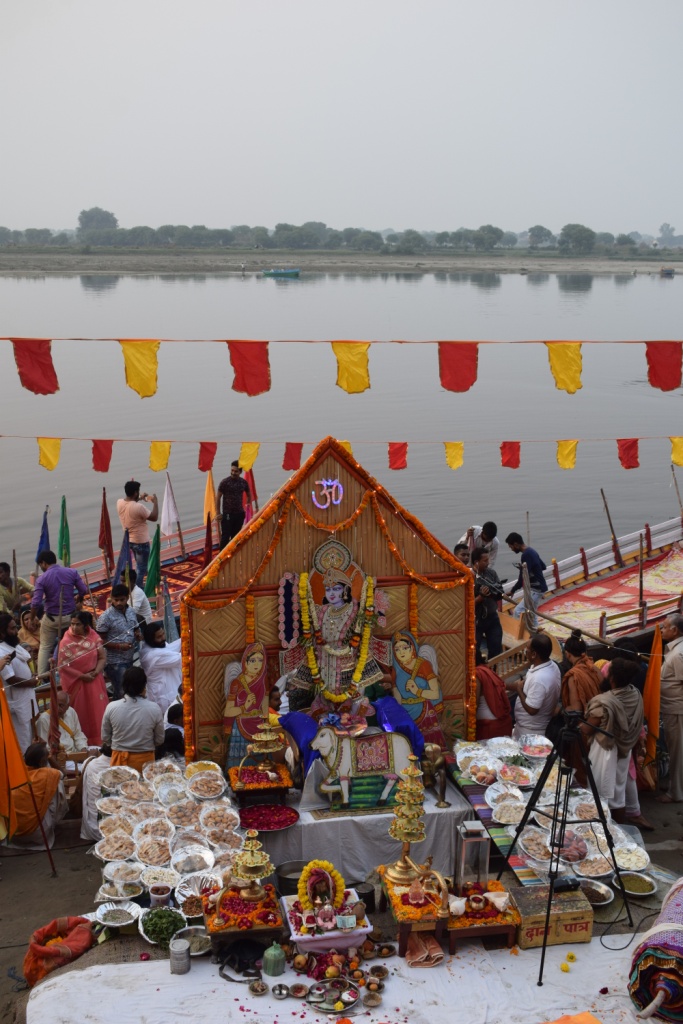

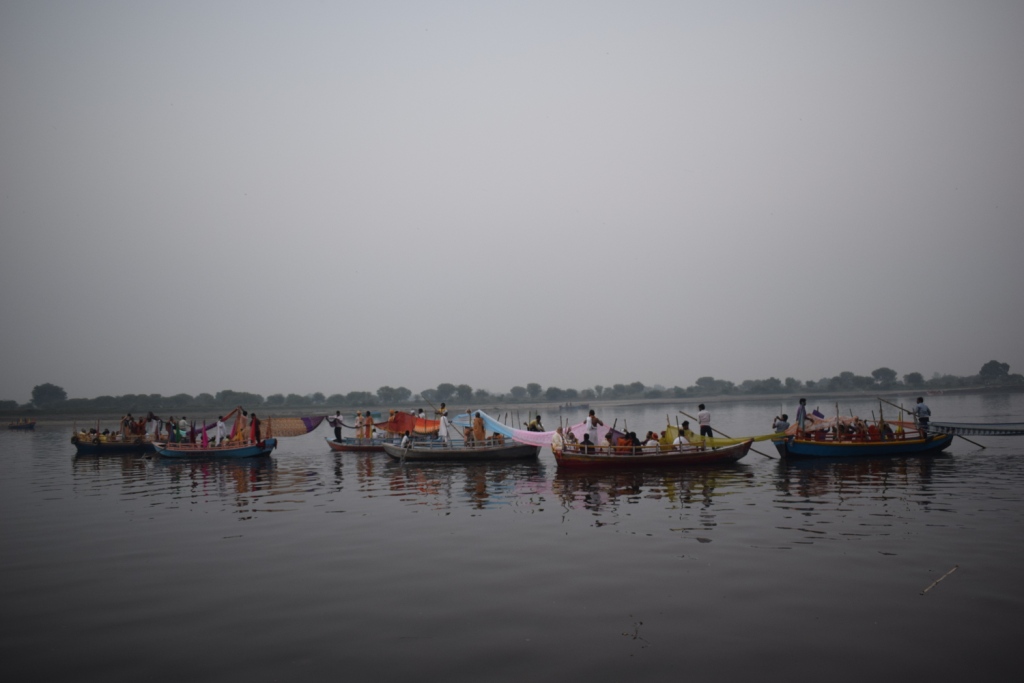

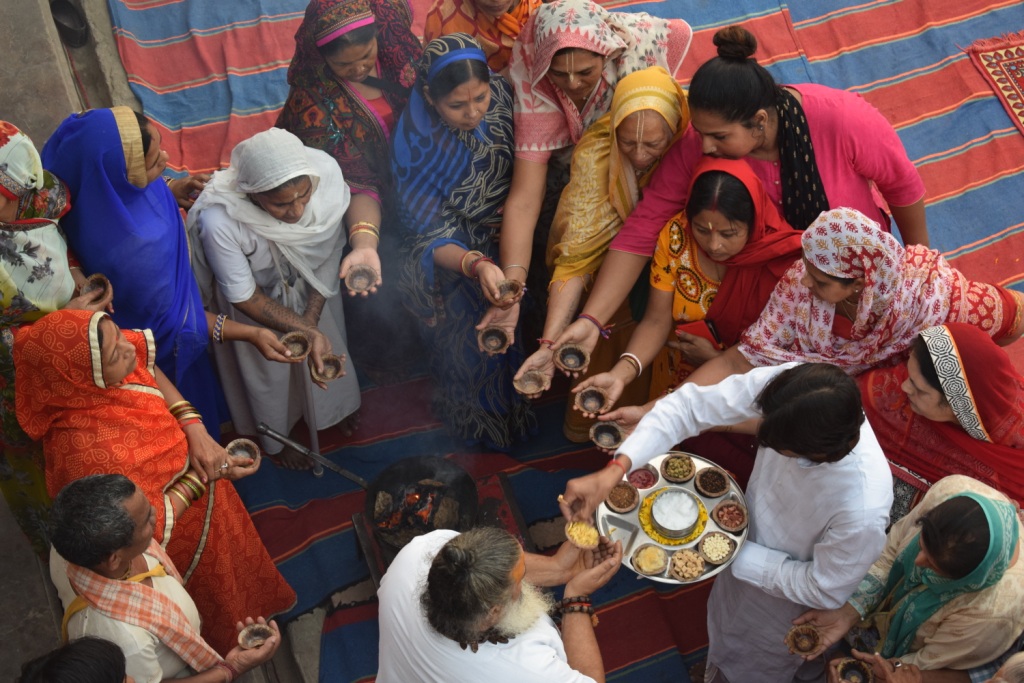


Holi and Vrindavan seem made for each other, the colours of Holi seem to immerse the people in the all-encompassing divine love of Krishna. Your words and pictures bring alive this wonderful experience. Especially loved the sunset at Barsana temple.
LikeLiked by 1 person
Vrindavan is on my annual travel list. Its a place, like you rightly say, is simple and simply reconnects you to your own deeper self, whether you are religious or not, its a good experience.
LikeLiked by 1 person
I have never been to Vrindavan but have heard so much. The pictures here depicts the essence of the place.
LikeLiked by 1 person
Vrindavan defines so many things in life and colors is one of the factors and must say you have roped in all the colors if Vrindavan in the post so well.
LikeLiked by 1 person